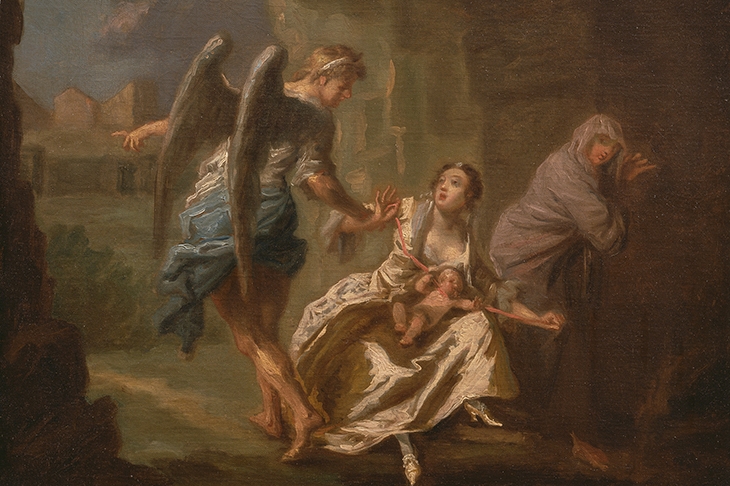At the heart of Basic Instincts, the new exhibition at the Foundling Museum in London, is an extraordinarily powerful painting of a mother and baby. At one time the ‘Angel of Mercy’ was sold as a greetings card by its owner, the Yale Center of British Art in Connecticut, presumably intended as something you might send your own mother or child. But take a second glance and you might well wonder who bought the card and who they might have sent it to.
In Joseph Highmore’s Georgian scene, a young, fashionably dressed woman is splayed across the canvas, her feet in delicate silk shoes, a tiny baby, naked, resting precariously on her lap. On her left cowers a veiled figure in grey, resolutely turned away from her; on her right, a huge figure in classical robes and wearing a pair of massive feathery wings offers a guiding hand, pointing towards the buildings in the background which are meant to represent the Foundling Hospital, established in London in 1739. Closer study reveals that the delicate pink ribbon stretched between the woman’s hands is poised around the baby’s neck; a tiny pink brushstroke indicates the baby’s tongue, gasping for breath.
It becomes clear that this is not a typical virginal scene. The woman has been stopped in the nick of time from strangling her baby to death. But her fashionable silks, her desperate expression, the hooded, cowering figure all suggest the baby is the consequence of rape, not wanton sex, and the woman has been abused, ruined and now abandoned, possibly by the very people who are now looking at the painting. Her baby just-born, perhaps on that very spot, arrives not in a comfortable bed but in a dark cavern, outwith the safe domestic space.
There’s a shocking immediacy about the portrait, a sense that what is unfolding in the picture is happening around you. This woman could be your daughter, Highmore seems to be saying. The picture, from about 1746, was never put on public display. Highmore, who was a friend of the artist William Hogarth, a fellow governor of the Foundling Hospital and responsible for the image on the subscription roll, appears to have realised it was way ahead of its time. When it did eventually appear in a sale catalogue at Sotheby’s in the 1960s it was attributed to the more famous Hogarth, not Highmore, and described as ‘An angel succouring a foundling child’, the focus diverted from the mother’s actions to the act of mercy, of rescue.
Now at last it is being shown here for the first time, and at the end of an exhibition designed to show that Highmore (1692–1780) was much more than just a society painter, depicting the respectable front of the Georgian middle class. His choice of murder weapon — the pink ribbon — is a very poignant reminder of why the Foundling Hospital was established by Thomas Coram, a retired sea captain.
On his return from roaming the world in the 1720s Coram was shocked by all the starving, threadbare children he saw on the streets of his home city, abandoned and struggling to survive, and he determined to rescue them. The charitable foundation, which still bears his name and still works ‘to create better chances for children’, accepted 228 children between 1741 and 1745, schooled at the hospital and trained for future employment. Many of the mothers left a token as a distinguishing mark, in case they should ever be in a position to reclaim their child, and many of these tokens were ribbons, very often pink.
‘We need to rethink Highmore as an artist but also rethink that period, when even middle-class women were in danger of assault and social exclusion,’ says Dr Jacqueline Riding, curator of the exhibition. Another portrait on show is of the famous courtesan Teresia Phillips, who claimed to have fallen into prostitution after being raped at the age of 13. Highmore gave permission for the picture to be used as the frontispiece to her memoirs, published in 1748, and for a note to be inserted in the text indicating that the portrait could be seen at his studio in Lincoln’s Inn. It was an advertisement for his work, but it was also a huge risk, aligning himself with such a notorious female celebrity.
Visitors to his studio could also have viewed a portrait of ‘the noble Clarissa’, heroine of Samuel Richardson’s eponymous novel, also published in 1748. Clarissa, from an educated, wealthy family, dies of hunger and self-neglect after being abandoned by them for refusing to marry the man they had chosen for her and then duped and raped by her persecutor Lovelace. The novel was a huge success, some of the girls deposited at the Foundling Hospital were named after her, and it remains (at just under a million words, or four volumes of 600 pages apiece) perhaps the most profound dissection of male and female desire ever written.
Highmore’s earlier portraits of women are very much of their time — decorous, fashionable, somewhat dull. But his connection with the Foundling Hospital alerted him to the inequalities and injustices of his time and to the plight of women and children at the mercy of men who always held the keys. ‘Angel of Mercy’ still has the power to shock and, sadly, tells a very modern story.






Comments